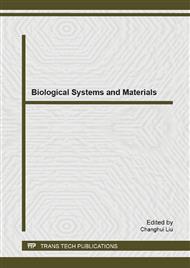[1]
F. Bennett III, B. Dolin and E. Rieffel: LNCS Vol. 2038 (2001), p.234.
Google Scholar
[2]
C.B. Keller and M. Ferrari, U.S. Patent 5, 893, 974. (1999).
Google Scholar
[3]
M. Koch, C. Schabmueller, A. Evans and A. Brunnschweiler, in: Proceedings of EUROSENSORS XII, edited by S. Middelhoek and J.W. Gardner, Institute of Physics Publishing (1998).
Google Scholar
[4]
Y. Ito: Nanotechnology Vol. 9 (1998), p.205.
Google Scholar
[5]
T. F. Otero: Proc. SPIE Vol. 3669 (1999), p.26.
Google Scholar
[6]
K. Drexler: Nanosystems: Molecular Machinery, Manufacturing, and Computation (John Wiley & Sons, USA 1992).
Google Scholar
[7]
R. Freitas Jr.: Nanotechnology Mag. Vol. 2 (1996), p.8.
Google Scholar
[8]
R. Freitas Jr.: Nanomedicine (Landes Bioscience, USA 1999).
Google Scholar
[9]
R. Amin, S. Kim, S. Park and T. LaBean: NANO Vol. 4 (2009), p.119.
Google Scholar
[10]
T. LaBean, K. Gothelf and J. Reif, in: Nanobiotechnology II: More Concepts and Applications, edited by C.A. Mirkin and C.M. Niemeyer, John Wiley & Sons (2007).
Google Scholar
[11]
N. Seeman: Sci. Am. Vol. 290 (2004), p.64.
Google Scholar
[12]
K. Lund, B. Williams, Y. Ke, Y. Liu and H. Yan: Curr. Nanosci. Vol. 2 (2006), p.113.
Google Scholar
[13]
Z. Deng, Y. Chen, Y. Tian and C. Mao, in: Nanotechnology: Science and Computation, edited by J. Chen, N. Jonoska and G. Rozenberg, Springer-Verlag (2006). P. Rothemund: Nature Vol. 440 (2006), p.297.
Google Scholar
[14]
E. Winfree, F. Liu, L. Wenzler and N. Seeman: Nature Vol. 394 (1998), p.539.
Google Scholar
[15]
F. Liu, R. Sha and N. Seeman: J. Am. Chem. Soc. Vol. 121 (1999), p.917.
Google Scholar
[16]
C. Mao, W. Sun and N. Seeman: J. Am. Chem. Soc. Vol. 121 (1999), p.5437.
Google Scholar
[17]
T. LaBean, H. Yan, J. Kopatsch, F. Liu, E. Winfree, J. Reif and N. Seeman: J. Am. Chem. Soc. Vol. 122 (2000), p.1848.
DOI: 10.1021/ja993393e
Google Scholar
[18]
C. Mao, T. LaBean, J. Reif and N. Seeman: Nature Vol. 407 (2000), p.493.
Google Scholar
[19]
W. Shih, J. Quispe and G. Joyce: Nature Vol. 427 (2004), p.618.
Google Scholar
[20]
S. Park, C. Pistol, S. Ahn, J. Reif, A. Lebeck, C. Dwyer and T. LaBean: Angew. Chem. Int. Ed. Vol. 45 (2006), p.735.
DOI: 10.1002/anie.200503797
Google Scholar
[21]
M. Mandel and J. Marmur: Meth. Enzymol. Vol. 12 (1968), p.198.
Google Scholar
[22]
M. Garey and D. Johnson: Computers and Intractability: A Guide to the Theory of NP-Completeness (W.H. Freeman, USA 1979).
Google Scholar
[23]
A. Gorbenko and V. Popov: Theor. Comput. Sci. Vol. 423 (2012), p.19.
Google Scholar
[24]
A. Gorbenko and V. Popov: Adv. Studies Theor. Phys. Vol. 6 (2012), p.1235.
Google Scholar
[25]
A. Gorbenko and V. Popov: Int. J. Automation and Computing Vol. 9 (2012), p.429.
Google Scholar


